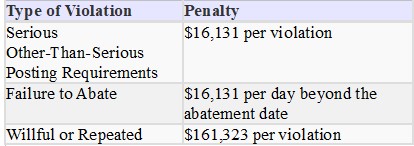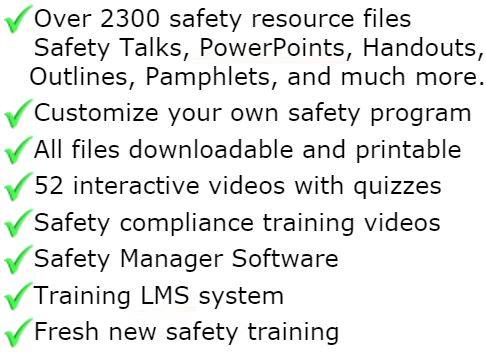
Compressed Gases Fact Sheet
This is a sample or partial document
Download the full customizable and printable version
OSHA Standard 1910.101
Compressed gases and cylinders must be properly stored, transported and used to prevent injury and accidents. Industrial gas cylinders are color coded to provide identification "at a glance". Regulators, cylinders and cylinder valves must be inspected regularly to ensure safe operation. Gases that may react with each other must be stored separately.
Hazards
• Oxygen displacement
• Explosion & fire hazards
• Toxic effect
• Physical hazards of a ruptured cylinder
Hazard Controls
• Color coding of cylinders
• Cylinder inspection
• Employee training
• Properly designed storage areas
• Segregation of empty & full cylinders
• Segregation of incompatible gasses
• Use of correct pressure regulators
OSHA Requires each employer to determine that compressed gas cylinders under his control are in a safe condition to the extent that this can be determined by visual inspection. Visual and other inspections shall be conducted as prescribed in the Hazardous Materials Regulations of the Department of Transportation (49 CFR parts 171-179 and 14 CFR part 103). Where those regulations are not applicable, visual and other inspections shall be conducted in accordance with Compressed Gas Association Pamphlets C-6-1968 and C-8-1962.
Storage of Compressed Gas Cylinders, including during use, must be designed to prevent prevent tipping, falling or rolling. Cylinders can be damaged or corrode if not stored or handled properly. Store cylinders in a cool, dry, well-ventilated, fire-resistant area that complies with federal, state and local regulations. Keep cylinder valve closed and cap installed when cylinder is not in use.
Personal Protective Equipment
• Use safety glasses when using compressed gas
• Use face shield & other required PPE for cryogenic gases
• Use air supplied respirators for toxic or oxygen displacing gasses
Work Area Safety
• Do not vent flammable gases inside a building
• Ensure bottles are secured in a proper storage area
• Keep oxygen stored away from flammables, grease and oil products
• Keep bottles capped when not in use
• Label all empty bottles
• Store bottles in ventilated dry area
Pre-Use Safety
• Check regulators for damage before using
• Ensure regulator valve is shut before installing on bottle
• Inspect all hoses before use
Operation Safety
• Use 30 psi or less when using compressed air for cleanup
• Secure bottles in upright position at work site to prevent tipping over
• Transport bottles with hand truck (secured)
• Open bottle valves and regulators slowly
• Never attempt to refill a gas bottle
• If a bottle valve leaks - take outdoors and slowly empty bottle
• Do not smoke near compressed gas bottles
• Never rely on the color of the cylinder for identification.
• Never attempt to repair a cylinder or valve
• Firmly attach cylinders to a bench top, wall, or holding cage. Use chains or sturdy straps
• Shut the cylinder valve when gas is not in use
• Open cylinder valves slowly.
• Never fully open cylinder cylinder valves.
• Don't store acetylene cylinders on their side• Never bleed a cylinder below 25 psi.
• Close all valves and replace caps before moving
• Store empty and full cylinders in separate areas
• Label all cylinders EMPTY or FULL
• Use safety glasses or face shield when handling or connecting gas cylinders
• Never roll or drag cylinders
• Move only one cylinder at a time

GET INSTANT ACCESS
to THE MEMBERS LIBRARY
Safety materials created by safety professionals.
Access to the Safety Manager software.
Wide variety of safety videos and courses.
**Brand New** Safety Training Management System
Pre-Made Safety Materials Ready For Use
Created by experienced safety professionals & risk consultants. Saving you time, money, and risk of injuries.
95% of the work already done.
Below are the maximum penalty amounts, with the annual adjustment for inflation, that may be assessed after Jan. 15, 2024. (See OSHA Memo, Jan. 8, 2024).

**New OSHA HEAT 90 DAY**
>>Download Free HERE<<
**New 2024 OSHA 300 Form**
>>Download Free HERE<<
**Brand New**
Free with full membership subscription
Training LMS System
Ask The Safety Consultant
Safety Equipment Deal Finder

“SafetyInfo.com is the first go-to website for safety professionals and companies to use in establishing a solid safety program"
-Mike McKenzie, Certified Safety & Health Manager (CSHM), McSafety Solutions™
Note: You must have a full subscription to the Safety Library in order to use this material. Any use outside of your organization, for resell, or without an active membership is strictly prohibited and may result in prosecution under copyright infringement laws. Please contact us first, if you would be interested in reselling or using our materials for reproduction.
Inside the Members Library
Topic Index
Accident Prevention
Air Quality
Asbestos
Bloodborne Pathogens
Boilers
Chemical Safety
Compressed Gas
Confined Space
Construction
Construction Worksite
Cranes & Slings
Driver / Fleet Safety
Drug Free Workplace
Electrical
Emergency Management
Engineering Safety
Environmental
Equipment
Ergonomics
Fall Protection
Fire Safety & Prevention
First Aid
Flammable Materials
Forklifts
Hazard Communication
Hazardous Materials
Hearing Protection
Heat Stress
Hot Work
Housekeeping
Job Safety Analysis
Laboratory
Ladders
Lead
Lockout-Tagout
Machinery & Equipment
Material Handling
MSDS (SDS)
Medical & First Aid
Occupational Health
Office Safety
Off the Job Safety
Personal Protection
Process Safety
Record Keeping
Respiratory Protection
Silica Safety
Rules & Policies
Signs & Labels
Slips, Trips & Fall
Training
Terrorism Programs
Tool Safety
Vehicle & Driver
Violence Programs
Welding & Hot Work
Training Videos
Library Index
Training Materials
Videos/Courses
Talks
Articles
PowerPoint
Handouts
Training Overheads
Quizzes
Supervisor Briefs
Management Briefs
Safety Sessions
2 Minute OSHA Safety Talks
Pamphlets
First Aid Training
Supervisor Training
Hazardous Materials
Bomb Threat
Crossword Puzzles
Biological Agents
Forms & Documents
Forms
Checklists
Audit Guides
Inspections Guides
Signs & Labels
Environmental Audit Guides
Recordkeeping - OSHA 300
Sign & Label Maker
Safety Management Resources
Safety Manuals/Written Programs
Ergonomic Programs
Emergency Plans
Process Safety Management
Construction Safety
Occupational Health
Environmental
Topic Sheets
DOT Fleet-Driver
Hazardous Materials
Chemical Safety
Drug Free Workplace
Terrorism Programs
Development Guides
Safety Manager Software
Safety References & Graphics
Technical Safety Information
Posters
Topic & Fact Sheets
Development Information
Job Specific Safety Rules
Terrorism
Calculators
Safety Comic Strips
New Safety Training System
Schedule and train your employees with our materials. Add unlimited amount of employees. Record all progress and issue certificates. For group and individual training sessions.

